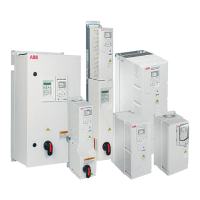2.
Remove the front cover(s) if not already removed. See page 174 (R1…R4), page
178 (R5) or page 83 (R6…R9).
Analog signals
The figures for frames R1…R2 and R3 (page 197), R4 (page 198), R5 (page 199) and
R6…R9 (page 200) show an example of connecting a cable. Make the connections
according to the default configuration.
3. Remove the rubber grommets from the cable entry for the cables to be connected.
Attach cable conduits to the empty cable entry holes. Slide the cables through the
cable conduits.
4. Frames R5…R9: Secure the cables mechanically at the clamps below the control
unit.
Ground also the pair-cable shields and grounding wire at the SCR terminal, or either,
you may ground the shield at the source of the signal, but do not ground it at both
the source of the signal and the SCR terminal.
5.
Route the cable as shown in the figures for frames R1…R2 and R3 (page 197), R4
(page 198), R5 (page 199) and R6…R9 (page 200).
6. Connect the conductors to the appropriate terminals of the control unit and tighten
to 0.5…0.6 N·m (0.4 lbf·ft).
Digital signals
The figures for frames R1…R2 and R3 (page 197), R4 (page 198), R5 (page 199) and
R6…R9 (page 200) show an example of connecting a cable. Make the connections
according to the default configuration.
7. Remove the rubber grommets from the cable entry for the cables to be connected.
Attach cable conduits to the empty cable entry holes. Slide the cables through the
cable conduits.
8. Frames R5…R9: Secure the cables mechanically at the clamps below the control
unit.
If you use double-shielded cables, ground also the pair-cable shields and grounding
wire at the SCR terminal.
9.
Route the cable as shown in the figures for frames R1…R2 and R3 (page 197), R4
(page 198), R5 (page 199) and R6…R9 (page 200).
10. Connect the conductors to the appropriate terminals of the control unit and tighten
to 0.5…0.6 N·m (0.4 lbf·ft).
11. Tie all control cables to the provided cable tie mounts.
Electrical installation – North America 195

